Have you ever pursued an adventure, but didn’t know what you were getting yourself into?
In 1998, I read Into Thin Air by Jon Krakauer, a book detailing the disasters of the 1996 Everest climbing season in which eight climbers died. I was fascinated by the thought of climbing the Big E, but my fascination didn’t last long – too expensive…too dangerous…way beyond my skills. After a bit of research and inquiry, I shifted my attention to a more reasonable goal – trekking to the Mount Everest Base Camp. To the accompaniment of Bob Seger’s song, I made plans to fly to “K-k-k-k-k-k Katmandu!”
I trekked with Camp Five Expeditions. They sent me a list of the specialized gear I’d need for the mountains. A friend referred me to an expedition outfitter in central Florida. The sign in front of the small, windowless building promised “Gateway to Adventures since 1945.” My wife, Paula, and I stepped inside. There was no doubt we were in the right place. The salesman went down my list…check, check, and check. He kept taking things to the cash register. My financial discomfort rose in proportion to the price tags on the growing pile of gear on the counter. The last item on the list was a sleeping bag. The bag highly recommended by the salesman was $250. My list noted that I could rent a sleeping bag in Kathmandu. I imagined that rental might be $20-$30. I compared that with the $250 sleeping bag in front of me. I said, “I think I’ll rent.” Paula said, “You’re going too far to skip on something important like this. It’s going to be cold there.” In an act of juvenile rebellion, I replied with words I would later regret…“Nope, I’ll rent.”
I flew into Kathmandu the morning of November 8, 1999. Camp 5 met me in the airport lobby and escorted me to their van through the chaos outside. The ride to the Hotel Shankar was like Space Mountain on steroids. No traffic lights. Potholes, people, dogs, cows, cabs, and garbage populated the narrow streets. No one used their brakes or turn signals. Blaring horns were used to establish right-of-way. The experience was frantic. I felt blessed to make it to the hotel alive.
That afternoon I met our guide, Mike, his wife Jennie and the seven trekkers I was going to spend the next eighteen days with. Mike sent us out to explore the city together that afternoon – baptism by immersion in the experience that was Kathmandu. Instead of being excited, I was anxious. I didn’t have a map. I didn’t know the language. I felt conspicuous and vulnerable. I was afraid I would look up and find myself alone – abandoned to find my way back to the hotel on my own.
The following day we explored more of the city. It felt as if I was a character in an Indiana Jones movie — everything was so exotic. So many contrasts: beautiful people and ragged beggars, praying monks and blaring horns, sweet smelling incense and stinking, burning garbage. Mike took me to a local outfitter to make last-minute purchases. He told me to ask for a sleeping bag rated to minus 20 degrees Fahrenheit. I did. They even showed me the tag. The tag lied!
Mike also told me to get a couple of candles for my tent. What? I knew that an open flame in a tent violates every tenting safety code ever written. Even so, I did as I was told. I found two small candles for 79 Rupees (≈ $1.00) each. The curved, red clay holders were inscribed with intricate, inscrutable designs. Each was about the size and shape of a baseball cut in half.
On the morning of the 10th, we flew out of Kathmandu for the mountains. Our destination was Lukla, “Gateway to the Himalayas.” Our plane wasn’t pressurized. The stewardess gave us a piece of candy to chew on to help equalize the pressure in our ears and cotton to muffle the sound of the engines. The plane bounced abruptly in shifting mountain air currents as we passed just above the tops of some of the peaks. I wondered what would happen if either of our engines hiccupped.
The airport at Lukla hangs on the side of a mountain at 9,300-foot-altitude. Planes land uphill and take off downhill. The unpaved runway begins just beyond the top of a 2,000-foot cliff and ends 1,600 feet later at a mountain wall. There is no place to recover from pilot error or equipment malfunction. The only choices are to land the first try, or crash. I didn’t understand this before we arrived. My first inkling of the potential danger was when we swept over the crumpled and burned bodies of several aircraft just before we touched down. There wasn’t enough time to worry. The pilot put the plane down hard, applied brakes and gave the engines reverse thrust. We approached the terminal area in a cloud of dust. I learned later that the airport is considered, by some, to be the most dangerous in the world. A line of yaks tied to the fence along the runway gave us indifferent stares – Welcome to the Himalayas.
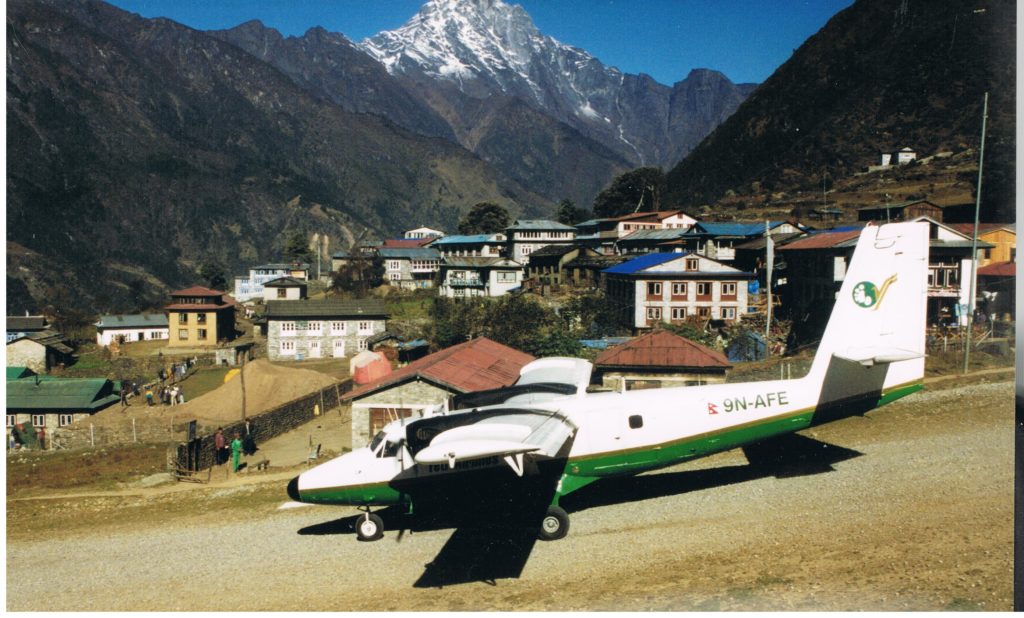
That afternoon we began our trek towards the Mt. Everest Base Camp — 100 miles out and back. Rugged, cold, beautiful! The trail was like a highway – yak trains, porters, and trekkers going both ways. The first day was designed to be an easy hike – not too hard, not too far…mostly downhill. Even so, I struggled to breathe. Several times I tried to take a breath but couldn’t. It felt as if a belt was snugged around my chest. Not knowing what else to do with it, I carried my video camera in a large case hung around my neck. My 35mm camera was hung on the opposite side of my body. The straps choked me. Trekkers heading back at the end of their trip walked by and snickered at me. Fear rose in my chest — I wondered how I would make it to 18,400 feet if I couldn’t breathe at 9,000 feet while going downhill. Mike asked me how I was doing. I lied and said “Great.”
To make things worse, one of our group had arrived at the mountains with a respiratory viral infection. What if I caught it? Could I go on? I did my best to avoid her — easy enough during the day when we were hiking. Avoidance was more difficult at night when we shared an evening meal. We usually ate sitting around folding tables under a blue dining canopy. We sat shoulder-to-shoulder in the cold while passing plates of food, served family style, around the table. Gas lanterns, hanging above us hissed while we shared laughter and conversation about the day’s hike. Coughing and hacking punctuated our words. Each cough felt like a nail being driven in my coffin.
Did I mention that it was cold? I was cold for two weeks. It was worst during the night. Sleeping in a tent in the Himalayas was an adventure, but not fun. Our tents were little two-person tents — bright blue outside with yellow interiors. They protected us from the wind, but from the cold? Not at all. Most mornings when we got up, there was a thin covering of ice on the outside of our tents. Anything that was wet when we went to bed was rock hard in the morning. Bathing was an optional evening adventure. No bath houses. No hot water. I’d strip in the confines of my tent, then dance in the freezing cold air while I wiped myself down with “Handiwipes.”
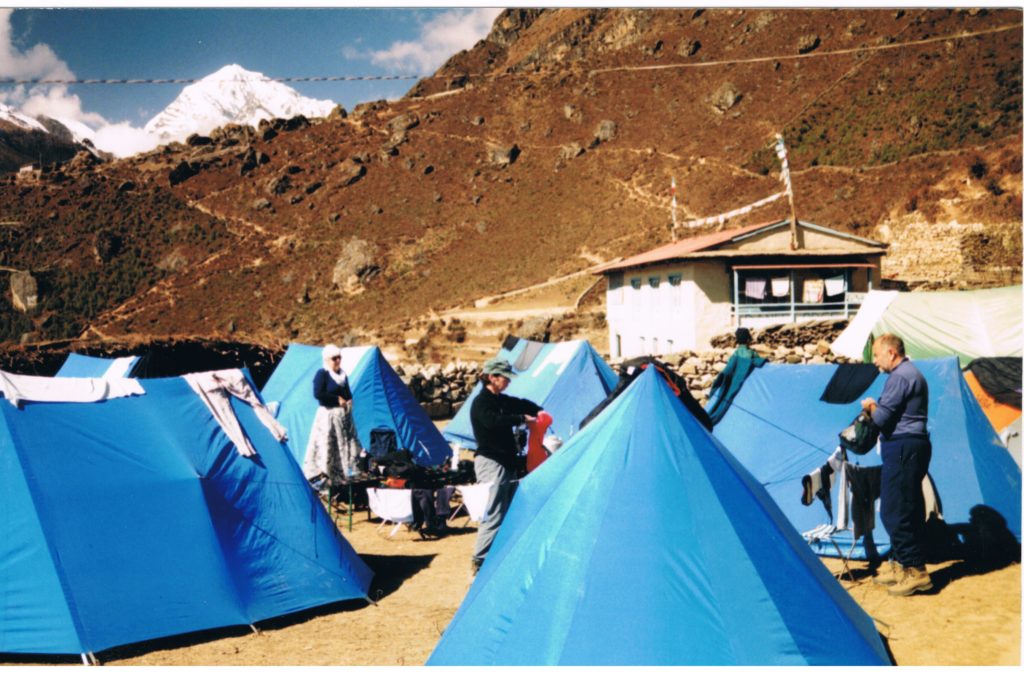
Each morning our crew would leave our campsite ahead of us with our gear. By the time we arrived at camp that night, our tents were up with our gear already inside. My gear consisted of a large, black duffel bag crammed with 40 pounds of camping stuff, my rented sleeping bag stuffed in a sack, and a large case that I stored my cameras in during the night. My tent seemed roomy until I unzipped my duffel and started taking things out. Once my bag’s zipper was undone, my gear started crawling out like fiddler crabs escaping an overturned bait bucket, until every bit of the tent floor was covered. Getting everything back in the bag each morning was an ordeal made more difficult by the finger-numbing cold.
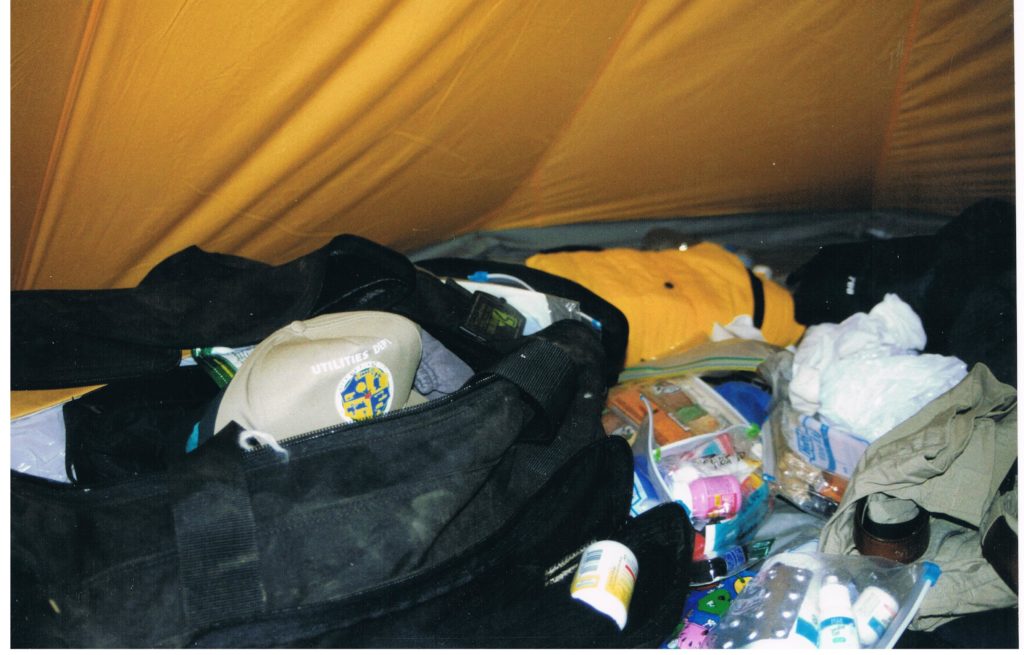
The first night in the mountains, we camped at 8,000 feet at a village called Phakding. The temperature fell to 40 degrees. Six nights later and 16,000 feet at Lobuche, the temperature dropped to single digits.
Each morning, a crew member would come to our tents and ask whether we wanted a cup of milk-tea or milk-coffee. I always asked for milk-coffee as I passed my cup to them. I liked the smell and taste of the coffee, but it was the warmth of the cup cradled in my hands which I appreciated the most. Following coffee, our crew returned to bring us a cupful of warm, not hot, washing water for cleaning our hands and face before breakfast. The warm water was a fleeting luxury. Any delay in using it resulted in “YEOW” — inducing, icy washing water.
It didn’t take me but a night or two in the mountains, to realize that my sleeping bag was a bust. The higher we went, the colder the nights were. I kept crawling in the bag with more and more clothes. By the time we were sleeping at 16,000 feet, I was wearing two heavy pairs of socks, long johns, trekking pants, medium weight fleece shirt, gloves, and balaclava. I still froze my butt off.
Sometimes we misunderstand the decisions we are making because of a lack of information. Back in Florida, I erroneously thought I was comparing apples to apples – money for money — making a choice of being warm for a little money versus being warm for a lot of money. I assumed that the sleeping bag I would rent in Nepal would be the equivalent of the sleeping bag I would buy in Florida. That was not a good assumption!
“Assumptions are unopened windows that foolish birds fly into, and their broken bodies are evidence gathered too late.” ― Bryan Davis
There were a couple of things that did help me stay a little warm. Each night, one of the crew would stop by our tents, pick up our water bottles, and fill them for the next day’s hike. They used boiling water, which sanitized the bottles and turned them into nifty foot warmers when slid to the bottom of our sleeping bags.
The other thing which helped keep me warm were the little candles I bought in Kathmandu. With my foot warmer bottle at the bottom of my sleeping bag, I would slip down inside. I’d turn on my side and light one of the candles. The candle’s warmth was largely symbolic. I would put my bare hand above the dancing little flame. It would warm my hand, and by extension, my entire body. The inside of my tent took on a golden glow that pushed back the veil of homesickness I felt. Before rolling over and trying to find a comfortable position to sleep, I would send off a prayer for Paula and then blow out the tiny little flame that helped me get through the night in the mountains of Nepal.

I struggled with the altitude every day of our week-long climb towards Base Camp. I hadn’t imagined that breathing could become any more difficult, but then it did. Two nights before summiting, I came down with the respiratory viral infection I had been afraid of. The timing couldn’t have been worse. Summit day was the payoff for all of the pain. It was the most physically challenging day of the trek (and of my life) and now…I was sick. Fellow trekker, Gitta, developed symptoms about the same time as I did.
Milk-coffee on summit day was at 4 a.m. Our camp was at the settlement of Lobuche (near 16,000 feet) which we left in the 6 a.m. dark when the temperature was 11 degrees. (Gitta remained behind and would attempt to summit the following day.) The trail was rocky, icy, and steep. In places, we had to scramble over boulders. Each step was an ordeal. I was congested, my head was aching, and I felt extreme fatigue. It felt as if there was a belt cinched around my chest preventing me from breathing. The congestion made me feel as if I was drowning. Hari, our crew chief, asked me to go back to Lobuche with one of the crew and try again the next day with Gitta. I declined — I was afraid I might not have the resolve to try again. We reached our first destination, the tiny settlement of Gorakshep about 10:30. By the time we arrived, I felt as if I was having a sunstroke.
Gorakshep sits at 16,900 feet. For climbers planning to summit Everest, it is the final settlement before reaching Everest Base Camp three kilometers farther along the trail. The structure of Everest is such that its summit is not visible from Base Camp. For that reason, most trekkers (like us) turn to the north and take a trail which climbs above Gorakshep to a ridge called Kala Patthar at 18,400 feet, on the south side of Pumori peak where the view of Everest and the Khumbu Icefall is unimpeded. As I looked towards the trail we would follow, I felt fear. The hardest part of the day’s climb was still ahead of us. Fifteen-hundred feet of elevation gain in 1.2 kilometers at an altitude where oxygen was only 50% of its saturation at sea level. We began by crossing an icy, sandy plain followed by an increasingly steep climb up a snowy, boulder-covered hillside. I followed Maureen and Hari one painful step at a time. Every few steps I had to stop and lean on my walking stick to catch my breath. Fellow hiker, Dave, was coughing up blood as he reached the summit (a symptom of High-Altitude Pulmonary Edema). Hari took my hand the last few hundred feet to help me keep from falling in the field of boulders.
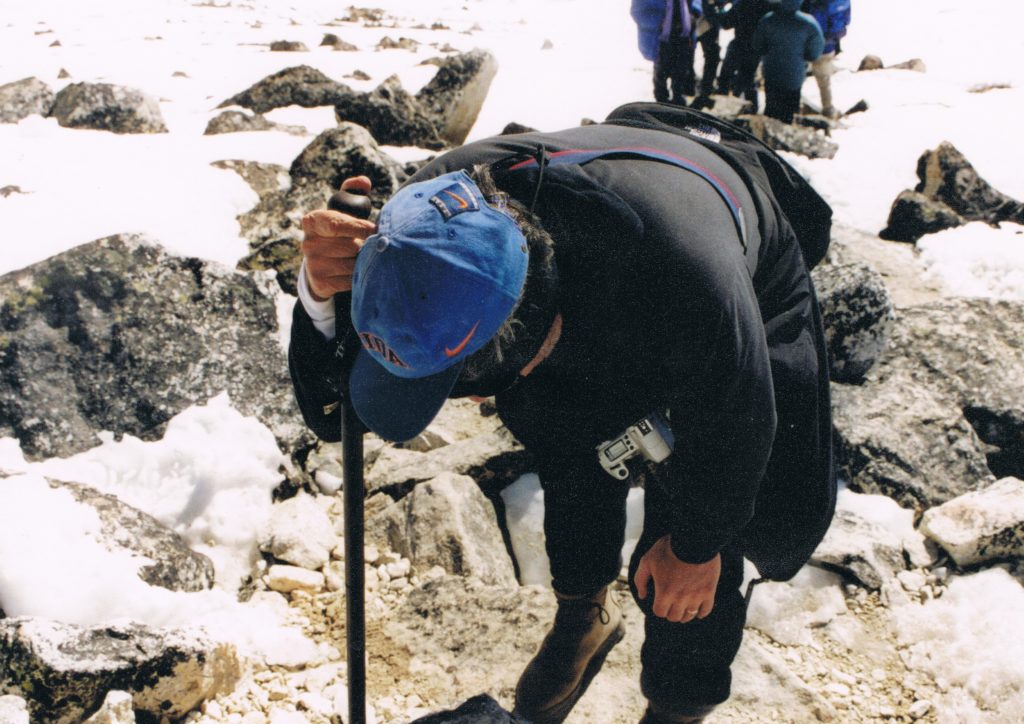
We all made it (Gitta would be up the next day). I could see a mountain in Tibet from where I was standing. I was only six miles from the summit of Mt. Everest — the highest point in the entire world. It was beautiful and windy and cold. We hugged, took pictures, and went “woo-hoo.” We were only at the summit for 30 minutes — it seemed not enough somehow, but I didn’t complain when we began our descent. I was empty, both physically and mentally. I just wanted to have a warm meal, climb into my not-warm sleeping bag, and pass out. As we started down, a few of my new friends tried to lift my spirits by singing an improvised Dionne Warwick hit: “Do you know the way to Lobuche?” I didn’t — gravity led me back to camp.
Adventures are funny things. They come in many shapes and sizes. Some of them are big complicated challenges, like hiking in the mountains of Nepal. Others are much more subtle, like giving a speech or joining the choir at church. The neat thing is that we’re hardly ever alone. There is almost always someone going in the same direction with a similar goal. Mike, Hari, and Maureen each reached out to share their light with me on summit day and throughout the trek. They carried my pack, guided me by hand and shared words of encouragement. I would not have made it without their help. The world is a better place when we let our light shine to help those we meet on our journey through life. Sometimes they help us. Sometimes we help them. Sometimes we’re the hand. Sometimes we’re the flame!
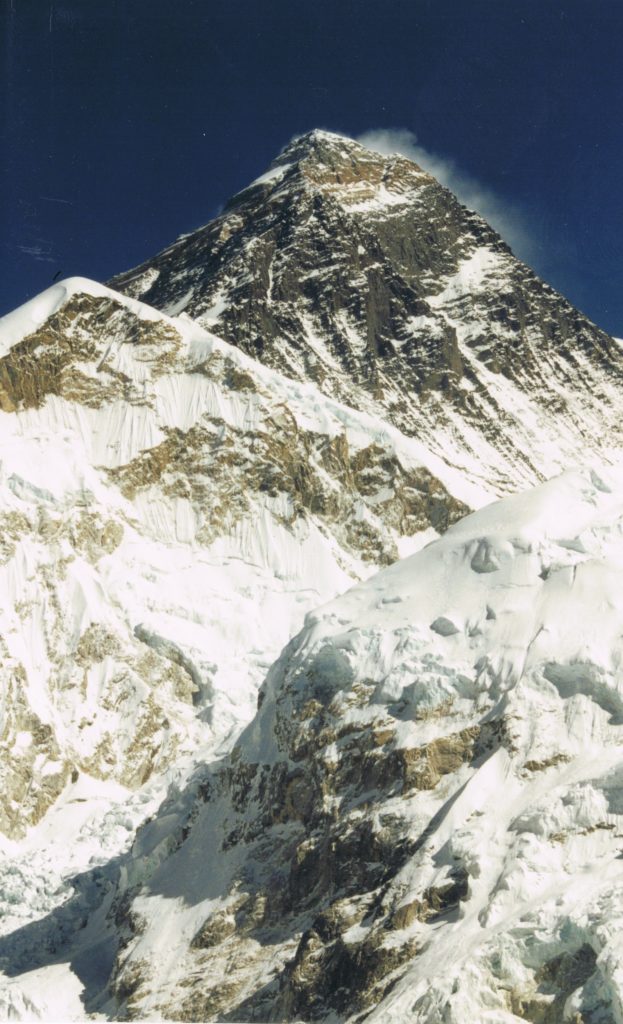
Thus was awesome. I kept going couldn’t stop.
Hi Chris. Thank you! I’m glad you liked it.
Bravo, my friend, Bravo~! Well done!
Hey Pat. Thank you. As always, I appreciate your encouragement.
Would appreciate a favor. I’m not sure if this message system is working on my website. Would you private message me on FB when you get this.
Great story Joe! I cringed at time and giggled at times! I have much admiration for your resolve and strength. Yes, I said strength!!!
Hi Lori. Thank you. Your affirmation means a lot to me.
Wow, Joe you are by far more adventurous than I. I love your stories and the way you articulate the words. Keep up the good work!!
Hi Mike. I’m glad you liked it. I appreciate your friendship.
I admire your strength and tenacity to do this climb, combined with your humility to take a hand when in need. So many daily life parallels …. thank you for
Sharing, Joe!
Hi Anne. Thank you so much. Your words mean a lot.
Hey Joe!
I hope you keep writing.
You are good … dang-darn good!
Thank you Paula…